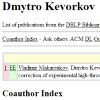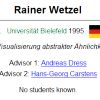| |
 
David Bryant and
Vincent Moulton. NeighborNet: An Agglomerative Method for the Construction of Phylogenetic Networks. In MBE, Vol. 21(2):255-265, 2004.
Keywords: phylogenetic network, phylogeny, Program SplitsTree, reconstruction, split network.
Note: http://www.math.auckland.ac.nz/~bryant/Papers/04NeighborNet.pdf.
Toggle abstract
"We present Neighbor-Net, a distance based method for constructing phylogenetic networks that is based on the Neighbor-Joining (NJ) algorithm of Saitou and Nei. Neighbor-Net provides a snapshot of the data that can guide more detailed analysis. Unlike split decomposition, Neighbor-Net scales well and can quickly produce detailed and informative networks for several hundred taxa. We illustrate the method by reanalyzing three published data sets: a collection of 110 highly recombinant Salmonella multi-locus sequence typing sequences, the 135 "African Eve" human mitochondrial sequences published by Vigilant et al., and a collection of 12 Archeal chaperonin sequences demonstrating strong evidence for gene conversion. Neighbor-Net is available as part of the SplitsTree4 software package."
|
|
| |
  
Andreas W. M. Dress,
Daniel H. Huson and
Vincent Moulton. Analyzing and visualizing distance data using SplitsTree. In DAM, Vol. 71(1):95-109, 1996.
Keywords: abstract network, from distances, phylogenetic network, phylogeny, Program SplitsTree, software, split network, visualization.
Note: http://bibiserv.techfak.uni-bielefeld.de/splits/splits.pdf.
|
|
| |
 
Andreas W. M. Dress and
Daniel H. Huson. Constructing splits graphs. In TCBB, Vol. 1(3):109-115, 2004.
Keywords: abstract network, circular split system, from trees, phylogenetic network, phylogeny, Program SplitsTree, reconstruction, split network, visualization.
Note: http://scilib.kiev.ua/ieee/tcbb/2004/03/n3/n0109.pdf.
Toggle abstract
"Phylogenetic trees correspond one-to-one to compatible systems of splits and so splits play an important role in theoretical and computational aspects of phylogeny. Whereas any tree reconstruction method can be thought of as producing a compatible system of splits, an increasing number of phylogenetlc algorithms are available that compute split systems that are not necessarily compatible and, thus, cannot always be represented by a tree. Such methods include the split decomposition, Neighbor-Net, consensus networks, and the Z-closure method. A more general split system of this kind can be represented graphically by a so-called splits graph, which generalizes the concept of a phylogenetic tree. This paper addresses the problem of computing a splits graph for a given set of splits. We have implemented all presented algorithms in a new program called SplitsTree4. © 2004 IEEE."
|
|
| |
 
Philippe Gambette and
Daniel H. Huson. Improved Layout of Phylogenetic Networks. In TCBB, Vol. 5(3):472-479, 2008.
Keywords: abstract network, heuristic, phylogenetic network, phylogeny, Program SplitsTree, software, split network, visualization.
Note: http://hal-lirmm.ccsd.cnrs.fr/lirmm-00309694/en/.
Toggle abstract
"Split networks are increasingly being used in phylogenetic analysis. Usually, a simple equal-angle algorithm is used to draw such networks, producing layouts that leave much room for improvement. Addressing the problem of producing better layouts of split networks, this paper presents an algorithm for maximizing the area covered by the network, describes an extension of the equal-daylight algorithm to networks, looks into using a spring embedder, and discusses how to construct rooted split networks. © 2008 IEEE."
|
|
| |
   
Daniel H. Huson,
Tobias Dezulian,
Tobias Kloepper and
Mike Steel. Phylogenetic Super-Networks from Partial Trees. In TCBB, Vol. 1(4):151-158, 2004.
Keywords: abstract network, from unrooted trees, phylogenetic network, phylogeny, Program SplitsTree, reconstruction, supernetwork.
Note: http://hdl.handle.net/10092/3177.
Toggle abstract
"In practice, one is often faced with incomplete phylogenetic data, such as a collection of partial trees or partial splits. This paper poses the problem of Inferring a phylogenetic super-network from such data and provides an efficient algorithm for doing so, called the Z-closure method. Additionally, the questions of assigning lengths to the edges of the network and how to restrict the "dimensionality" of the network are addressed. Applications to a set of five published partial gene trees relating different fungal species and to six published partial gene trees relating different grasses illustrate the usefulness of the method and an experimental study confirms Its potential. The method Is implemented as a plug-in for the program SplitsTree4. © 2004 IEEE."
|
|
| |
|
| |
 
Daniel H. Huson and
David Bryant. Application of Phylogenetic Networks in Evolutionary Studies. In MBE, Vol. 23(2):254-267, 2006.
Keywords: abstract network, phylogenetic network, phylogeny, Program SplitsTree, software, survey.
Note: http://dx.doi.org/10.1093/molbev/msj030, software available from www.splitstree.org.
Toggle abstract
"The evolutionary history of a set of taxa is usually represented by a phylogenetic tree, and this model has greatly facilitated the discussion and testing of hypotheses. However, it is well known that more complex evolutionary scenarios are poorly described by such models. Further, even when evolution proceeds in a tree-like manner, analysis of the data may not be best served by using methods that enforce a tree structure but rather by a richer visualization of the data to evaluate its properties, at least as an essential first step. Thus, phylogenetic networks should be employed when reticulate events such as hybridization, horizontal gene transfer, recombination, or gene duplication and loss are believed to be involved, and, even in the absence of such events, phylogenetic networks have a useful role to play. This article reviews the terminology used for phylogenetic networks and covers both split networks and reticulate networks, how they are defined, and how they can be interpreted. Additionally, the article outlines the beginnings of a comprehensive statistical framework for applying split network methods. We show how split networks can represent confidence sets of trees and introduce a conservative statistical test for whether the conflicting signal in a network is treelike. Finally, this article describes a new program, SplitsTree4, an interactive and comprehensive tool for inferring different types of phylogenetic networks from sequences, distances, and trees. © The Author 2005. Published by Oxford University Press on behalf of the Society for Molecular Biology and Evolution. All rights reserved."
|
|
| |

François-Joseph Lapointe. How to account for reticulation events in phylogenetic analysis: A review of distance-based methods. In Journal of Classification, Vol. 17:175-184, 2000.
Keywords: abstract network, evaluation, from distances, phylogenetic network, Program Pyramids, Program SplitsTree, Program T REX, pyramid, reconstruction, reticulogram, split network, survey, weak hierarchy.
Note: http://dx.doi.org/10.1007/s003570000016.
|
|
| |

David A. Morrison. Networks in phylogenetic analysis: new tools for population biology. In IJP, Vol. 35:567-582, 2005.
Keywords: median network, NeighborNet, phylogenetic network, phylogeny, population genetics, Program Network, Program Spectronet, Program SplitsTree, Program T REX, Program TCS, reconstruction, reticulogram, split decomposition, survey.
Note: http://hem.fyristorg.com/acacia/papers/networks.pdf.
|
|
| |
 
David Posada and
Keith A. Crandall. Intraspecific gene genealogies: trees grafting into networks. In TEE, Vol. 16(1):37-45, 2001.
Keywords: likelihood, median network, netting, parsimony, phylogenetic network, phylogeny, Program Arlequin, Program SplitsTree, Program T REX, Program TCS, pyramid, reticulogram, split decomposition, statistical parsimony, survey.
Note: http://darwin.uvigo.es/download/papers/09.networks01.pdf.
|
|
| |
|
| |
 
Tobias Kloepper and
Daniel H. Huson. Drawing explicit phylogenetic networks and their integration into SplitsTree. In BMCEB, Vol. 8(22), 2008.
Keywords: explicit network, phylogenetic network, phylogeny, Program SplitsTree, software, split network, visualization.
Note: http://dx.doi.org/10.1186/1471-2148-8-22.
Toggle abstract
"Background. SplitsTree provides a framework for the calculation of phylogenetic trees and networks. It contains a wide variety of methods for the import/export, calculation and visualization of phylogenetic information. The software is developed in Java and implements a command line tool as well as a graphical user interface. Results. In this article, we present solutions to two important problems in the field of phylogenetic networks. The first problem is the visualization of explicit phylogenetic networks. To solve this, we present a modified version of the equal angle algorithm that naturally integrates reticulations into the layout process and thus leads to an appealing visualization of these networks. The second problem is the availability of explicit phylogenetic network methods for the general user. To advance the usage of explicit phylogenetic networks by biologists further, we present an extension to the SplitsTree framework that integrates these networks. By addressing these two problems, SplitsTree is among the first programs that incorporates implicit and explicit network methods together with standard phylogenetic tree methods in a graphical user interface environment. Conclusion. In this article, we presented an extension of SplitsTree 4 that incorporates explicit phylogenetic networks. The extension provides a set of core classes to handle explicit phylogenetic networks and a visualization of these networks. © 2008 Kloepper and Huson; licensee BioMed Central Ltd."
|
|
| |
  
Steven M. Woolley,
David Posada and
Keith A. Crandall. A Comparison of Phylogenetic Network Methods Using Computer Simulation. In PLoS ONE, Vol. 3(4):e1913, 2008.
Keywords: abstract network, distance between networks, evaluation, median network, MedianJoining, minimum spanning network, NeighborNet, parsimony, phylogenetic network, phylogeny, Program Arlequin, Program CombineTrees, Program Network, Program SHRUB, Program SplitsTree, Program TCS, split decomposition.
Note: http://dx.doi.org/10.1371/journal.pone.0001913.
Toggle abstract
"Background: We present a series of simulation studies that explore the relative performance of several phylogenetic network approaches (statistical parsimony, split decomposition, union of maximum parsimony trees, neighbor-net, simulated history recombination upper bound, median-joining, reduced median joining and minimum spanning network) compared to standard tree approaches (neighbor-joining and maximum parsimony) in the presence and absence of recombination. Principal Findings: In the absence of recombination, all methods recovered the correct topology and branch lengths nearly all of the time when the subtitution rate was low, except for minimum spanning networks, which did considerably worse. At a higher substitution rate, maximum parsimony and union of maximum parsimony trees were the most accurate. With recombination, the ability to infer the correct topology was halved for all methods and no method could accurately estimate branch lengths. Conclusions: Our results highlight the need for more accurate phylogenetic network methods and the importance of detecting and accounting for recombination in phylogenetic studies. Furthermore, we provide useful information for choosing a network algorithm and a framework in which to evaluate improvements to existing methods and novel algorithms developed in the future. © 2008 Woolley et al."
|
|
| |
   
James B. Whitfield,
Sydney A. Cameron,
Daniel H. Huson and
Mike Steel. Filtered Z-Closure Supernetworks for Extracting and Visualizing Recurrent Signal from Incongruent Gene Trees. In Systematic Biology, Vol. 57(6):939-947, 2008.
Keywords: abstract network, from unrooted trees, phylogenetic network, phylogeny, Program SplitsTree, split, split network, supernetwork.
Note: http://www.life.uiuc.edu/scameron/pdfs/Filtered%20Z-closure%20SystBiol.pdf.
|
|
| |

Daniel H. Huson. Drawing Rooted Phylogenetic Networks. In TCBB, Vol. 6(1):103-109, 2009.
Keywords: explicit network, phylogenetic network, phylogeny, Program Dendroscope, Program SplitsTree, visualization.
Note: http://dx.doi.org/10.1109/TCBB.2008.58.
Toggle abstract
"The evolutionary history of a collection of species is usually represented by a phylogenetic tree. Sometimes, phylogenetic networks are used as a means of representing reticulate evolution or of showing uncertainty and incompatibilities in evolutionary datasets. This is often done using unrooted phylogenetic networks such as split networks, due in part, to the availability of software (SplitsTree) for their computation and visualization. In this paper we discuss the problem of drawing rooted phylogenetic networks as cladograms or phylograms in a number of different views that are commonly used for rooted trees. Implementations of the algorithms are available in new releases of the Dendroscope and SplitsTree programs. © 2006 IEEE."
|
|
| |
|
| |
  
Gabriel Cardona,
Francesc Rosselló and
Gabriel Valiente. Extended Newick: It is Time for a Standard Representation. In BMCB, Vol. 9:532, 2008.
Keywords: evaluation, explicit network, phylogenetic network, Program Bio PhyloNetwork, Program Dendroscope, Program NetGen, Program PhyloNet, Program SplitsTree, Program TCS, visualization.
Note: http://bioinfo.uib.es/media/uploaded/bmc-2008-enewick-sub.pdf.
|
|
| |

David A. Morrison. Using data-display networks for exploratory data analysis in phylogenetic studies. In MBE, Vol. 27(5):1044-1057, 2010.
Keywords: abstract network, hybridization, NeighborNet, Program SplitsTree, recombination, split decomposition.
Note: http://dx.doi.org/10.1093/molbev/msp309.
Toggle abstract
"Exploratory data analysis (EDA) is a frequently undervalued part of data analysis in biology. It involves evaluating the characteristics of the data "before" proceeding to the definitive analysis in relation to the scientific question at hand. For phylogenetic analyses, a useful tool for EDA is a data-display network. This type of network is designed to display any character (or tree) conflict in a data set, without prior assumptions about the causes of those conflicts. The conflicts might be caused by 1) methodological issues in data collection or analysis, 2) homoplasy, or 3) horizontal gene flow of some sort. Here, I explore 13 published data sets using splits networks, as examples of using data-display networks for EDA. In each case, I performed an original EDA on the data provided, to highlight the aspects of the resulting network that will be important for an interpretation of the phylogeny. In each case, there is at least one important point (possibly missed by the original authors) that might affect the phylogenetic analysis. I conclude that EDA should play a greater role in phylogenetic analyses than it has done. © 2010 The Author. Published by Oxford University Press on behalf of the Society for Molecular Biology and Evolution. All rights reserved."
|
|
| |

Robert G. Beiko. Gene sharing and genome evolution: networks in trees and trees in networks. In Biology and Philosophy, Vol. 25(4):659-673, 2010.
Keywords: abstract network, explicit network, from rooted trees, galled network, phylogenetic network, phylogeny, Program Dendroscope, Program SplitsTree, reconstruction, split network, survey.
Note: http://dx.doi.org/10.1007/s10539-010-9217-3.
Toggle abstract
"Frequent lateral genetic transfer undermines the existence of a unique "tree of life" that relates all organisms. Vertical inheritance is nonetheless of vital interest in the study of microbial evolution, and knowing the "tree of cells" can yield insights into ecological continuity, the rates of change of different cellular characters, and the evolutionary plasticity of genomes. Notwithstanding within-species recombination, the relationships most frequently recovered from genomic data at shallow to moderate taxonomic depths are likely to reflect cellular inheritance. At the same time, it is clear that several types of 'average signals' from whole genomes can be highly misleading, and the existence of a central tendency must not be taken as prima facie evidence of vertical descent. Phylogenetic networks offer an attractive solution, since they can be formulated in ways that mitigate the misleading aspects of hybrid evolutionary signals in genomes. But the connections in a network typically show genetic relatedness without distinguishing between vertical and lateral inheritance of genetic material. The solution may lie in a compromise between strict tree-thinking and network paradigms: build a phylogenetic network, but identify the set of connections in the network that are potentially due to vertical descent. Even if a single tree cannot be unambiguously identified, choosing a subnetwork of putative vertical connections can still lead to drastic reductions in the set of candidate vertical hypotheses. © 2010 Springer Science+Business Media B.V."
|
|
| |
  
Changiz Eslahchi,
Mahnaz Habibi,
Reza Hassanzadeh and
Ehsan Mottaghi. MC-Net: a method for the construction of phylogenetic networks based on the Monte-Carlo method. In BMCEB, Vol. 10:254, 2010.
Keywords: abstract network, circular split system, from distances, heuristic, phylogenetic network, Program MC-Net, Program SplitsTree, software, split, split network.
Note: http://dx.doi.org/10.1186/1471-2148-10-254.
Toggle abstract
"Background. A phylogenetic network is a generalization of phylogenetic trees that allows the representation of conflicting signals or alternative evolutionary histories in a single diagram. There are several methods for constructing these networks. Some of these methods are based on distances among taxa. In practice, the methods which are based on distance perform faster in comparison with other methods. The Neighbor-Net (N-Net) is a distance-based method. The N-Net produces a circular ordering from a distance matrix, then constructs a collection of weighted splits using circular ordering. The SplitsTree which is a program using these weighted splits makes a phylogenetic network. In general, finding an optimal circular ordering is an NP-hard problem. The N-Net is a heuristic algorithm to find the optimal circular ordering which is based on neighbor-joining algorithm. Results. In this paper, we present a heuristic algorithm to find an optimal circular ordering based on the Monte-Carlo method, called MC-Net algorithm. In order to show that MC-Net performs better than N-Net, we apply both algorithms on different data sets. Then we draw phylogenetic networks corresponding to outputs of these algorithms using SplitsTree and compare the results. Conclusions. We find that the circular ordering produced by the MC-Net is closer to optimal circular ordering than the N-Net. Furthermore, the networks corresponding to outputs of MC-Net made by SplitsTree are simpler than N-Net. © 2010 Eslahchi et al; licensee BioMed Central Ltd."
|
|
| |
    
Changiz Eslahchi,
Reza Hassanzadeh,
Ehsan Mottaghi,
Mahnaz Habibi,
Hamid Pezeshk and
Mehdi Sadeghi. Constructing circular phylogenetic networks from weighted quartets using simulated annealing. In MBIO, Vol. 235(2):123-127, 2012.
Keywords: abstract network, from quartets, heuristic, phylogenetic network, phylogeny, Program SAQ-Net, Program SplitsTree, reconstruction, simulated annealing, software, split network.
Note: http://dx.doi.org/10.1016/j.mbs.2011.11.003.
Toggle abstract
"In this paper, we present a heuristic algorithm based on the simulated annealing, SAQ-Net, as a method for constructing phylogenetic networks from weighted quartets. Similar to QNet algorithm, SAQ-Net constructs a collection of circular weighted splits of the taxa set. This collection is represented by a split network. In order to show that SAQ-Net performs better than QNet, we apply these algorithm to both the simulated and actual data sets containing salmonella, Bees, Primates and Rubber data sets. Then we draw phylogenetic networks corresponding to outputs of these algorithms using SplitsTree4 and compare the results. We find that SAQ-Net produces a better circular ordering and phylogenetic networks than QNet in most cases. SAQ-Net has been implemented in Matlab and is available for download at http://bioinf.cs.ipm.ac.ir/softwares/saq.net. © 2011 Elsevier Inc."
|
|
| |
    
Stefan Grünewald,
Andreas Spillner,
Sarah Bastkowski,
Anja Bögershausen and
Vincent Moulton. SuperQ: Computing Supernetworks from Quartets. In TCBB, Vol. 10(1):151-160, 2013.
Keywords: abstract network, circular split system, from quartets, heuristic, phylogenetic network, phylogeny, Program QNet, Program SplitsTree, Program SuperQ, software, split network.
Toggle abstract
"Supertrees are a commonly used tool in phylogenetics to summarize collections of partial phylogenetic trees. As a generalization of supertrees, phylogenetic supernetworks allow, in addition, the visual representation of conflict between the trees that is not possible to observe with a single tree. Here, we introduce SuperQ, a new method for constructing such supernetworks (SuperQ is freely available at >www.uea.ac.uk/computing/superq.). It works by first breaking the input trees into quartet trees, and then stitching these together to form a special kind of phylogenetic network, called a split network. This stitching process is performed using an adaptation of the QNet method for split network reconstruction employing a novel approach to use the branch lengths from the input trees to estimate the branch lengths in the resulting network. Compared with previous supernetwork methods, SuperQ has the advantage of producing a planar network. We compare the performance of SuperQ to the Z-closure and Q-imputation supernetwork methods, and also present an analysis of some published data sets as an illustration of its applicability. © 2004-2012 IEEE."
|
|
| |
  
Alexey A. Morozov,
Yuri P. Galachyants and
Yelena V. Likhoshway. Inferring Phylogenetic Networks from Gene Order Data. In BMRI, Vol. 2013(503193):1-7, 2013.
Keywords: abstract network, from distances, from gene order, NeighborNet, phylogenetic network, phylogeny, Program SplitsTree, reconstruction, split decomposition, split network.
Toggle abstract
"Existing algorithms allow us to infer phylogenetic networks from sequences (DNA, protein or binary), sets of trees, and distance matrices, but there are no methods to build them using the gene order data as an input. Here we describe several methods to build split networks from the gene order data, perform simulation studies, and use our methods for analyzing and interpreting different real gene order datasets. All proposed methods are based on intermediate data, which can be generated from genome structures under study and used as an input for network construction algorithms. Three intermediates are used: set of jackknife trees, distance matrix, and binary encoding. According to simulations and case studies, the best intermediates are jackknife trees and distance matrix (when used with Neighbor-Net algorithm). Binary encoding can also be useful, but only when the methods mentioned above cannot be used. © 2013 Alexey Anatolievich Morozov et al."
|
|
| |
 
Jialiang Yang,
Stefan Grünewald,
Yifei Xu and
Xiu-Feng Wan. Quartet-based methods to reconstruct phylogenetic networks. In BMC Systems Biology, Vol. 80(21), 2014.
Keywords: abstract network, from quartets, phylogenetic network, phylogeny, Program QuartetMethods, Program QuartetNet, Program SplitsTree, reconstruction.
Note: http://dx.doi.org/10.1186/1752-0509-8-21
.
Toggle abstract
"Background: Phylogenetic networks are employed to visualize evolutionary relationships among a group of nucleotide sequences, genes or species when reticulate events like hybridization, recombination, reassortant and horizontal gene transfer are believed to be involved. In comparison to traditional distance-based methods, quartet-based methods consider more information in the reconstruction process and thus have the potential to be more accurate.Results: We introduce QuartetSuite, which includes a set of new quartet-based methods, namely QuartetS, QuartetA, and QuartetM, to reconstruct phylogenetic networks from nucleotide sequences. We tested their performances and compared them with other popular methods on two simulated nucleotide sequence data sets: one generated from a tree topology and the other from a complicated evolutionary history containing three reticulate events. We further validated these methods to two real data sets: a bacterial data set consisting of seven concatenated genes of 36 bacterial species and an influenza data set related to recently emerging H7N9 low pathogenic avian influenza viruses in China.Conclusion: QuartetS, QuartetA, and QuartetM have the potential to accurately reconstruct evolutionary scenarios from simple branching trees to complicated networks containing many reticulate events. These methods could provide insights into the understanding of complicated biological evolutionary processes such as bacterial taxonomy and reassortant of influenza viruses. © 2014 Yang et al.; licensee BioMed Central Ltd."
|
|
| |
|
| |
  
Monika Balvociute,
Andreas Spillner and
Vincent Moulton. FlatNJ: A Novel Network-Based Approach to Visualize Evolutionary and Biogeographical Relationships. In Systematic Biology, Vol. 63(3):383-396, 2014.
Keywords: abstract network, flat, phylogenetic network, phylogeny, Program FlatNJ, Program SplitsTree, split network.
Note: http://dx.doi.org/10.1093/sysbio/syu001.
Toggle abstract
"Split networks are a type of phylogenetic network that allow visualization of conflict in evolutionary data. We present a new method for constructing such networks called FlatNetJoining (FlatNJ). A key feature of FlatNJ is that it produces networks that can be drawn in the plane in which labels may appear inside of the network. For complex data sets that involve, for example, non-neutral molecular markers, this can allow additional detail to be visualized as compared to previous methods such as split decomposition and NeighborNet. We illustrate the application of FlatNJ by applying it to whole HIV genome sequences, where recombination has taken place, fluorescent proteins in corals, where ancestral sequences are present, and mitochondrial DNA sequences from gall wasps, where biogeographical relationships are of interest. We find that the networks generated by FlatNJ can facilitate the study of genetic variation in the underlying molecular sequence data and, in particular, may help to investigate processes such as intra-locus recombination. FlatNJ has been implemented in Java and is freely available at www.uea.ac.uk/computing/software/ flatnj. [flat split system; NeighborNet; Phylogenetic network; QNet; split; split network.] © The Author(s) 2014."
|
|
| |
     
Sarah Bastkowski,
Daniel Mapleson,
Andreas Spillner,
Taoyang Wu,
Monika Balvociute and
Vincent Moulton. SPECTRE: a Suite of PhylogEnetiC Tools for Reticulate Evolution. In BIO, Vol. 34(6):1057-1058, 2018.
Keywords: abstract network, NeighborNet, phylogenetic network, phylogeny, Program FlatNJ, Program QNet, Program SplitsTree, reconstruction, software, split network.
Note: https://doi.org/10.1101/169177.
|
|
|
|
 - forked on GitHub.
- forked on GitHub.

















































